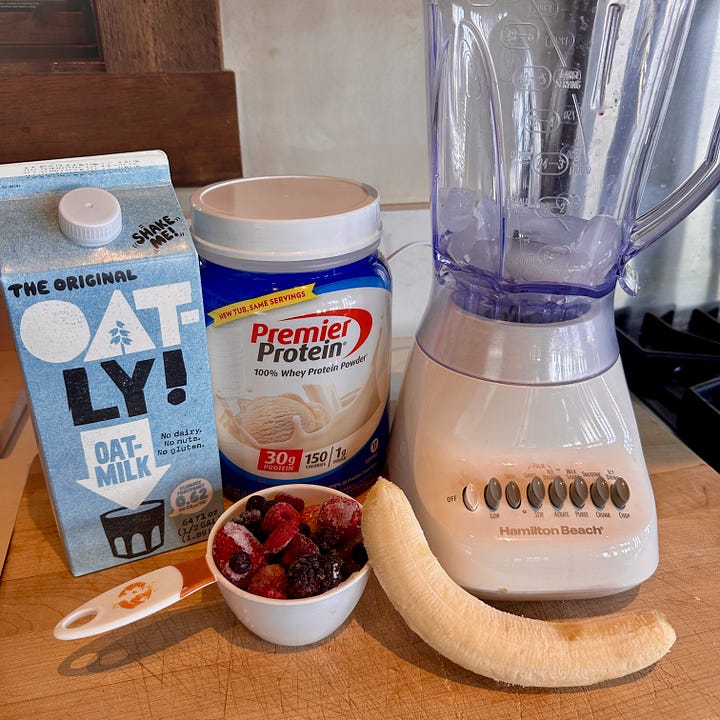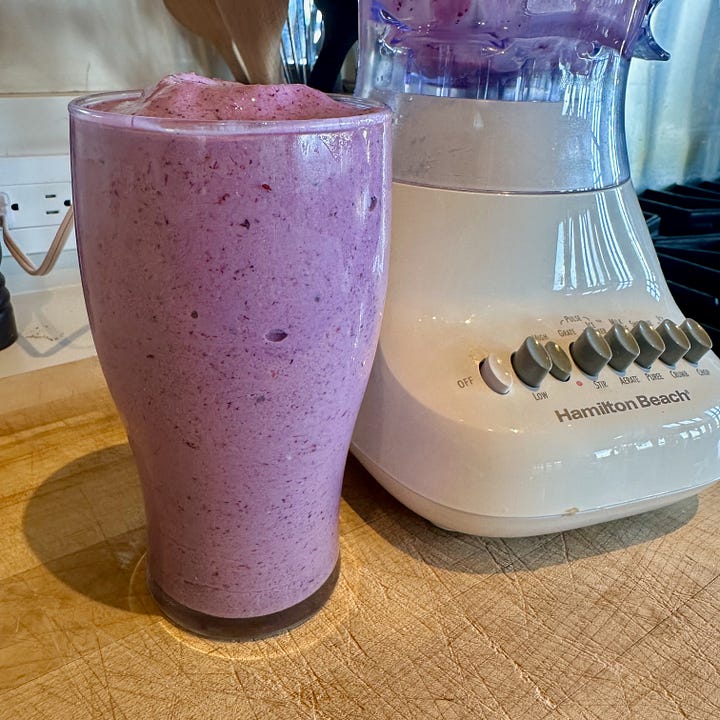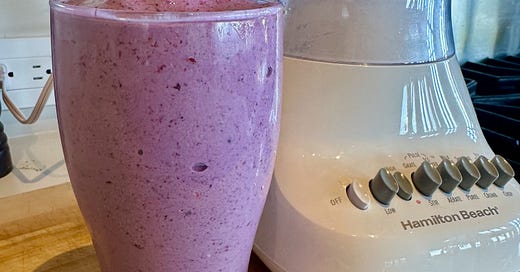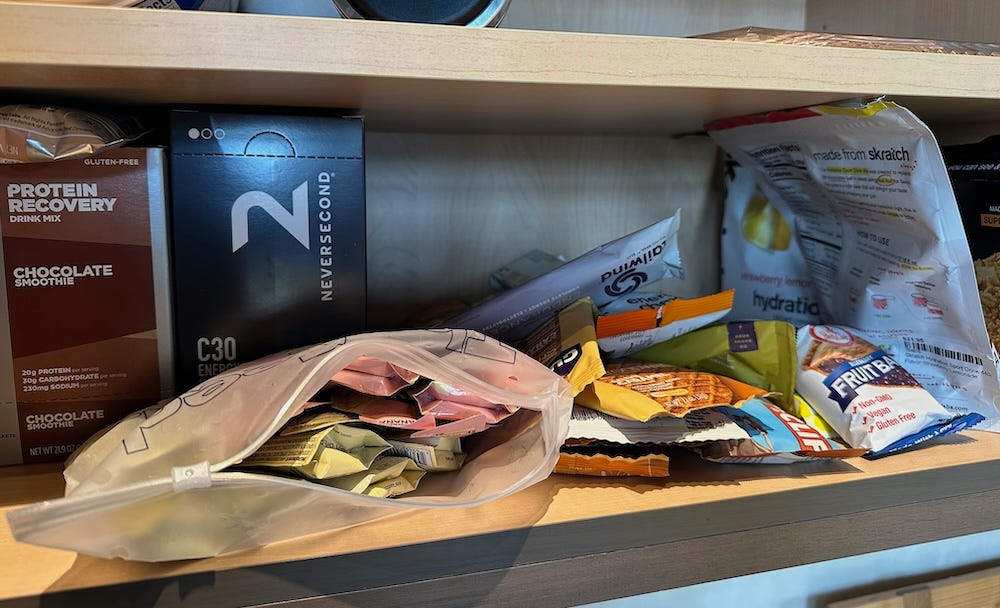Friends, I’m due for a cutback week, both with training and with this newsletter. Therefore, I’ll spitball some tips and updates for you below rather than dive into a topic with a longer narrative. I hope you like the mix!
A cutback week
When I coached others, and as I continue to coach myself, I reduce training volume every four to five weeks to build in greater recovery and to prevent burnout. Also, I don’t want to shoehorn higher mileage into a week involving travel, holidays, or other special occasions that disrupt a normal schedule.
I’m giving myself a light week coinciding with a family trip to Bozeman this Thursday through Sunday. I won’t run long this weekend; I’ll get out Saturday for a couple of hours tops and run like a tourist, exploring and taking in sites.
Generally speaking, consistency is key, and I’m proud of the gradual buildup I’ve achieved since restarting running post-injury in February, as shown by the graph below charting weekly mileage totals. (It doesn’t show strength training, which I’ve also increased.) I’ve re-adapted to 40 to 50 miles a week with a long run in the high teens to low 20s; Saturday, I stretched the long run to 26 mountainous miles.
Consistency also is key for producing a newsletter, and I’ve cranked this out every Wednesday going on four years. But some weeks I need to ease up and let ideas germinate.
How about you, do you need “a cutback week” in some aspect of your life? If so, take it!
Counting carbs because more is more
As mentioned in an earlier post, I’m working with sports nutritionist Kylee Van Horn (co-host of a podcast I recommend, Your Diet Sucks). My goal is to adapt my stomach to properly fuel and hydrate in a way that supports higher-volume run- and strength-training, and that prevents nausea, dehydration, and gut issues during the May 10 Quad Rock 50 and July 11 Hardrock Hundred.
I’d like to share some of the changes I’m making and the food I’m trying, specifically regarding mid-long-run fueling. (Our consulting is a lot more complex than what I highlight below; we also are fine-tuning pre- and post-run meals, aiming for daily targets of carb and protein based on my level of training for the day, and doing sweat tests to better understand my hydration and sodium needs. So please don’t think that what I mention below is all there is to her coaching.)
I have to admit, change is not easy for me! At almost 56, I am set in my ways. I think I know what’s best for me (because generally, I do). It’s not easy to modify my habits and train my gut to take in more when I’ve had a less-is-more mindset.
My conservative view of mid-ultra fueling has been shaped partly by concern about nausea and GI problems from ingesting too much—I fear the feeling of a gut bomb or stomach slosh—and partly by training for weeklong self-supported stage races where I limited calories (the 170-mile Grand to Grand Ultra in 2012, ‘14, 19, ‘24 and its spinoff the Mauna to Mauna in 2017). During those events, which featured no aid stations with snacks (only water was given), we needed to carry everything for the week in packs, including all our food, hence it was advantageous to go as light as possible. In preparation for those extreme ultras, I used to do “bonk runs” in training where I would deliberately under-fuel—say, take in maybe only one gel (25g of carbs) every other hour—to teach my body and mind that I could persevere and run through a low-energy bonk by burning more fat. Yep, I could do it—but my performance suffered, and it didn’t feel pleasant.
Now, we’re in the midst of a high-carb revolution in endurance sports where athletes and coaches are promoting more is better and shifting the mindset: Instead of thinking what’s the minimum we need, let’s push our intake limits and try to do more with more. I think this is healthier, but I need to get used to it. Many ultrarunners now aim for 60g to a mind-boggling 90g carbs/hour. I’m just trying to stretch myself toward the low end of that spectrum.
With Kylee’s help, I’m shifting from thinking that averaging 200 calories/hour during an ultra is plenty, to thinking it’s the minimum. Moreover, she is getting me to think in carbs/hour, not calories. In other words, I need to average at least 50g carbs/hour (which x4 = 200 calories), striving for 60.
I’m seeing results. Last Saturday, the elapsed time for my rugged high-vert marathon-length run (including breaks) was over seven hours. I was achy by the end, but not low on energy or mentally fatigued, nor did I have “bathroom problems.” I felt good eating and ran better because of the amount of carbs I ate and drank.
Given that Quad Rock 50 will take me at least 12 hours and Hardrock over 40 hours, it’s essential to figure out and practice fueling and hydration and, as best as possible, prevent an energy deficit. My body at a low-intensity ultra pace burns around 500 calories per hour, at least half of which come from carbohydrates. When it runs low on stored carbohydrate (aka glycogen) after a couple of hours, I need to replace those 250ish calories (around 62g carbs) hourly or otherwise experience the light-headed weakness that plagued my last several 100-milers.
Snack hacks
Practically speaking, targeting 50 - 60g carbs/hour mid-long-run means I’m looking for more high-carb snacks and hydration mixes instead of snacks like trail mix that fill me up with calories from protein and fat and are harder for the body to digest mid-run.
For example, one of my go-to fave snacks mid-long-run has always been a PB&J rollup in a flour tortilla. For a training run the other day, I omitted the peanut butter and put in an extra spoonful of jam, so I just had a jammy folded tortilla—a combo that makes for a satisfying 44g carbs. Plus, the tortilla was loaded with 250mg of sodium that I needed. And I thought, wow, this is really tasty and goes down easier—just jam without the PB—and provides a great energy boost! I’ve since started making pure-honey tortilla rollups too.
With this in mind, I’ve been exploring new and different sports nutrition while also trying to regain an acceptance for gels (which I swore off after post-gel puking at my last few 100s). Gels are efficient in this high-altitude dry climate where it’s difficult to chew and swallow solid food while moving on the trail. Over the past two months, I discovered these things work for me (and I am not sponsored; I have no stake in any of these recommendations):
After trying and disliking the texture/taste of both Maurten and Precision Fuel, I settled on Never Second gels, which have 30g carbs per packet. I’m also giving good-ol’ GU another try and was pleasantly surprised on my last long run that it didn’t make me gag.
I was seeking a bar that provides light, easy-to-swallow carbs, and less protein/fat, rather than a bar that feels heavy and chewy. I found it on the cereal aisle in the form of Kind’s Oats & Honey bar, highly palatable. It has the same calories (150) as a Honey Stinger Waffle or GU Stroopwafel, but more carbs (24g vs. 19 and 21 in the other products). It also feels more substantial and satisfying than the thin waffles. And it’s much less expensive!
I’ve fallen in love with Betty Lou’s fruit bars (42g carbs). They taste like a cross between a Fig Newton and a bite of pie.
After trying many chews, my fave is the chews by Skratch, because of their taste and for whatever reason they don’t stick in my molars (38g carbs/package).
I also use Skratch and Tailwind for hydration mix. I like one scoop of Skratch in one bottle (80 calories/20g carbs) and two scoops of Tailwind in the other (200 calories/50g carbs). However, I also like having plain water to wash down the gels, so as not to overload my stomach with sugar when I suck down a gel all at once. Therefore mid-run, I alternate between mixing in Skratch in one bottle and refilling it with plain water. Tailwind has a new extra-high-carb formula, but I have not tried it yet and don’t plan to anytime soon. 50g carbs/bottle feels thick and heavy enough to me as is.
I finally made and tested Jason Koop’s rice ball recipe (the kind with soy sauce, syrup, and a little bit of scrambled egg, not the bacon kind). They’re messy but delicious and satisfying. Two balls have about 40g carbs.
I’m taking cubed baked sweet potato in a baggie on more of my runs. One cup has a little over 25g carbs, so it’s similar to a gel, but more satisfying.
I’d love to hear about your mid-run high-carb snacks in the comments below.
A simple post-run smoothie
To meet Kylee’s specific protein + carb targets for hard training days, I often make a smoothie as a post-run or mid-afternoon snack. So many smoothie recipes exist, I thought I’d share mine as a basic and easy option.
This makes a large and filling smoothie—16 oz. with 440 calories/64g carbs/33g protein. If I’m hungry and/or have been on a depleting run, I enjoy the whole thing myself. If it’s a regular day with lower energy needs, I might split it with my husband.
A note about the base: I use oat milk, but you could use cow’s milk. I typically have a full cup of 2% cow’s milk in the morning steamed with my coffee, and I eat cheese, so I feel I get enough dairy and its saturated fat at other times of the day, hence my choice to use oat milk in the smoothie. But cow’s milk in it would boost your protein. (They’re the same calorie-wise, but a cup of regular oat milk has 3g protein and 16g carbs vs. a cup of 2% milk has 8g protein, 12g carbs.)
All you need is the following, then blend:
1 cup frozen berries
1 medium banana
whey protein (I put in two scoops of the kind I have for 30g protein)
1 cup oat milk
approx 1 cup ice cubes


A big project—and I’d appreciate your support!
I devoted untold hours over the past month to launch a community event, and honestly, I’m nervous it’ll flop. I’m experiencing the feeling of creating something new and putting myself out in public to promote it and imploring people to participate, all the while wondering in my mind, “Is this more trouble than it’s worth? Will anyone care?”
Then I remind myself, it’s for a really good cause!
As leader of Telluride Rotary Club (a nonreligious, nonpartisan community service club that’s part of Rotary International), I needed to think up a “fun”-raiser/fundraiser to support the club’s service projects and scholarships. I didn’t want to do another boozy auction—our community has “auction fatigue” from enough of those. I also couldn’t do something that requires a lot of hands-on work, like a golf tournament, because we don’t have enough volunteer power.
Being the trail enthusiast that I am, I came up with a twist on a traditional one-day walkathon (you know, the fundraiser that schools often do where parents and friends pledge a per-lap amount to a kid for walking around a track). I created a month-long hikeathon!
I and others will hike and log our miles in June. The money raised from donations or per-mile pledges will go toward the many positive things Telluride Rotary does in the community and worldwide, including: funding and organizing a youth exchange program, awarding scholarships to high school seniors, sponsoring a program to give free books monthly to any child age 0 - 5 in our county, supporting community service projects, and funding projects that further Rotary’s mission. For example, this year our club made a grant to fight malaria in Kenya and is joining other Rotary clubs to create a STEAM learning center on the Navajo nation.
Please consider participating as a hiker during the month of June! You can do it anywhere; you need not be in the Telluride region. Learn about it and sign up here: https://go.dojiggy.io/telluriderotaryhikeathon2025.
If you’re not interested in participating but would like to support it, then please donate to my campaign with either a one-time gift or a per-mile pledge; I set a goal to raise at least $2000 and would greatly appreciate your tax-deductible gift! Visit my fundraising page to make a donation.
I'm wrapping up my second year as president for Telluride Rotary. It’s by far my biggest volunteer commitment, and I’m proud of what our club accomplishes. In our polarized country and conflict-prone world, Rotary Club is needed as a big-tent organization that promotes peace and brings people together for common good with the motto “Service Above Self.” I’m also excited to have created an event that encourages people to get outdoors for health and camaraderie.
Thank you for reading this far!







Thanks for sharing your carb strategy in detail! I’ve been experimenting and have enjoyed Precision gels, as well as Huma, SiS and carbs gels. I find Gu a bit thick but enjoy some of the fruity flavours… I just can’t handle the creamy ones!
I love stroopwaffels and buy the regular 10-pack at the grocery store, which is way cheaper than the running-specific options. But the MVP of my big mountain run last summer was a small ziploc of butternut squash ravioli with a little bit of olive oil and a lot of salt—it was so nice to have a savoury option after hours of sweets!
I'm saving this for fueling ideas for a possible/likely ultra in July. I'm also wondering what, if anything, you've heard about the opposite kind of fueling: very low carbs. We hosted a friend for the Boston marathon who did exceptionally well and was working with a coach who was explicitly limiting carb intake. Low GI, too. Thoughts?